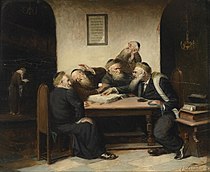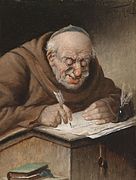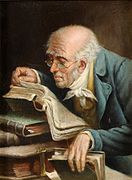| The topic of this article may not meet Misplaced Pages's notability guideline for biographies. Please help to demonstrate the notability of the topic by citing reliable secondary sources that are independent of the topic and provide significant coverage of it beyond a mere trivial mention. If notability cannot be shown, the article is likely to be merged, redirected, or deleted. Find sources: "Carl Schleicher" – news · newspapers · books · scholar · JSTOR (June 2024) (Learn how and when to remove this message) |
Carl Schleicher (born Cölestin Schleicher, 1825 – October 2, 1903) was a realistic painter from the 19th century.
Life
Schleicher was born in Lemberg (now Lviv), but he acquired his education in the field of painting mainly in Vienna between the years 1860 and 1870. He was a student of the Austrian painter Ferdinand Georg Waldmüller.
Schleicher is especially known for portrait paintings of faces, as well as interpretive paintings of rabbis who study the Talmud. A considerable amount of his paintings are oil paintings.
His paintings are an authentic record of Jewish culture and customs, as well as the rabbinic form of learning. These paintings have been exhibited several times at the Austrian Art Club (Österreichisches Kunstverein).
Schleicher's paintings are both interpretive and precise. He is depicting the pointed scholastic atmosphere of the Jewish rabbis studying the Talmud. One can see the heat of the debate on the faces and movements of the characters.
Schleicher died in Padua, Kingdom of Italy, in 1903.

Name
Although Schleicher was initially known in his hometown as Cölestin Schleicher, later he exhibited his work in Vienna and was acclaimed as Carl Schleicher, which is how he is mostly known since.
Paintings
Disciple of the Austrian painter Ferdinand Georg Waldmüller, Schleicher developed his work in costumbrist style, mainly in Vienna between 1859 and 1871. On several occasions he exhibited his work at the Österreichisches Kunstverein (Austrian Arts Club). Showing familiarity with Jewish life, Schleicher exhibited genre paintings with Jewish scenes.
He specialized in oil painting and shows the influence of Dutch Golden Age painting of the 17th century.
Schleicher is particularly known for the anecdotal component of his work. He individually portrayed the different characteristic types of his time, some of them dedicated to reading or writing. Among these works, The Drinker, The Card Player and The Musician stand out. The Scribe involves a Benedictine monk with glasses, busy writing something that he inscribes with the help of a pen on several papers. Preserved in the Bury Art Museum in Manchester, Study of an Old Man presents an old man with a cigar and a beer jug.
Some of Schleicher's paintings present genre scenes, such as Tavern Scene, Drinkers, In the tavern and The chess players.
Other works have a certain intimacy, notably La toilette and Grandma's birthday. The anecdotal nature of Schleicher's painting is in turn evident in works such as Thief in the artist's studio, Long live the wine, The broken container, A rare piece and The winning hand .
Schleicher also painted groups of priests and rabbis. The figure of the Christian priest is introduced individually in Old Man Writing a Diary and is taken up in group terms in The Chess Players, where a Benedictine monk measures himself against a Dominican one, while another, a Franciscan, observes the game between the two. As far as Judaism is concerned, Schleicher was particularly interested in rabbinic activity around the Talmud, thus creating works such as Rabbis in debate and A Talmudic dispute.
Paintings of rabbis and talmudists
A part of Carl Schleicher's output is closely related to Judaism and Ashkenazi life. The exchange of ideas and interpretations between the rabbis and talmudists was a topic to which Schleicher dedicated a considerable number of oil paintings. Loaded with anecdotal material, such paintings constitute a valuable record of the practices and customs of Ashkenazi Jews in Europe, whose culture and heritage are known as Yiddishkayt. Schleicher's record is valuable because most of Europe's Ashkenazi communities and their cultural diversity have been lost due to the Shoah.
The theme addressed by Schleicher concerns both the Jewish dialectical-exegetical experience and modern art. Schleicher's paintings are characterized by being not only descriptive, but also by sharply capturing the atmosphere of study that governed the life of the Talmudists: seriousness and dedication, with interesting dialogues and surprising ideas, but also problematic contradictions, endless arguments and humor.
-
 At the Rabbi's is a work that deals with the serious explanation given by an Ashkenazi leader about the Talmud.
At the Rabbi's is a work that deals with the serious explanation given by an Ashkenazi leader about the Talmud.
-
 In Jewish Scene I, Schleicher presents an elderly rabbi giving his interpretation of a certain matter through a haggadah from the Talmud.
In Jewish Scene I, Schleicher presents an elderly rabbi giving his interpretation of a certain matter through a haggadah from the Talmud.
-
 Jewish Scene II is a painting that shows Talmudists conversing about the meaning of a Talmudic passage.
Jewish Scene II is a painting that shows Talmudists conversing about the meaning of a Talmudic passage.
-
 Dramatic effect in A controversy from the Talmud, where Schleicher has portrayed the different attitudes of the Talmudists: conviction and assertiveness, opposition and rejection, attention and amazement.
Dramatic effect in A controversy from the Talmud, where Schleicher has portrayed the different attitudes of the Talmudists: conviction and assertiveness, opposition and rejection, attention and amazement.
External links
References
- ^ "Carl Schleicher". profilbaru.com.
- ^ Dimitra Reimüller, 19th Century Paintings: Carl (Cölestin) Schleicher, Dorotheum, 2014
- ^ "Carl Schleicher - Biography". www.askart.com.
- "Carl Schleicher", Arcadja, accessed June 5, 2014.
- Eventually, this work has been exhibited as A Discussion of the Talmud (Sotheby's, New York, 2011: ecatalogue/2011/important-judaica-n08814/lot.59.html A Discussion of the Talmud). However, on the reverse, the painting bears the inscription: "Eine rei Frage aus dem Talmud", implying that the theme of the work is A question from the Talmud or A question about the Talmud. Indeed, presenting a rabbi explaining a certain passage of the Talmud before a group of five scholars, the image in question has less to do with a discussion than with a rabbinic exegesis, this being corroborated by the German inscription on the back of the work.
- BBC of London, Sotheby's, Invaluable, Art Price, Ask Art, Identification of the painter's signature in Find Art Info
- "Van Ham: Carl Schleicher". Archived from the original on 2016-01-29. Retrieved 2024-05-30.
- Obituary published in Neue Freie Presse, October 2, 1903 (Dimitra Reimüller).
- Boris Wilnitsky, Carl Schleicher, Fine Art, Vienna, consulted January 22, 2016.
- "Heritage Auctions: The Scribe".
- "BBC: Study of an Old Man".
- Original title of the work is in German, Der Schuster.
- In German, Der Bücherwurm can be translated as both.
- Tavern Scene, c. 1870 (image).
- In German, Der Geburtstag der Großmutter (image).
- The Winnig Hand (The Winnig Hand) features an eighteenth-century pair of card players; one of the gentlemen is advised by a third party (image ).
- Among them The highlights include Any controversy from the Talmud (Eine Streitfrage aus dem Talmud), Rabbi scholars in a Debate, Talmudic Discussion, A Talmudic issue in dispute (An Issue of Dispute in the Talmud), and A Talmudic Dispute (Ein Talmudstreit); The titles of his works listed here are consonant with those of his works exhibited at MutualArt (accessed June 5, 2014).
- See Schleicher's paintings at MutualArt.



